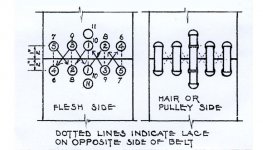Ronniet
Aluminum
- Joined
- Feb 21, 2011
- Location
- Amarillo Texas
I have been thinking when I finish up this project that I would like to try the glued serpentine belt method.
Is that still working?
My pulleys are 1.5 wide and I have been using a rubber conveyor belt cut down and metal laced and is far superior to the leather belt. But would like to get away from the click clack.
So I thought I would try the Black Shoe Goo and a 1.375 wide belt from a diesel.
wider mean more glue area and gripping strength?
Ron
Is that still working?
My pulleys are 1.5 wide and I have been using a rubber conveyor belt cut down and metal laced and is far superior to the leather belt. But would like to get away from the click clack.
So I thought I would try the Black Shoe Goo and a 1.375 wide belt from a diesel.
wider mean more glue area and gripping strength?
Ron



